Cold Revolution. Central and Eastern European Societies in Times of Socialist Realism, 1948-1959
Ausstellung zum Sozialistischen Realismus der Nachkriegszeit in der Nationalen Kunstgalerie Zachęta (Zachęta Narodowa Galeria Sztuki) in Warschau
Die Ausstellung Cold Revolution / Zimna Rewolucja ist noch bis zum 19. September 2021 in der Nationalen Kunstgalerie Zachęta (Zachęta Narodowa Galeria Sztuki) in Warschau zu sehen. Das Thema ist der gesellschaftliche Wandel in Ost- und Mitteleuropa in den 1950er Jahren im Kontext des Stalinismus und Poststalinismus. Die Kurator*innen Jérôme Bazin und Joanna Kordjak präsentieren über 400 Ausstellungsstücke aus den Bereichen Malerei, Grafik, Skulptur, Fotografie und Kino. Die Gemälde, Zeichnungen, Skulpturen, Fotografien und Filmausschnitte aus den Ländern des Ostblocks sind bislang größtenteils wenig bekannt und werfen neue Fragen nach der ästhetischen Bewertung der Kunst des „Sozialistischen Realismus“ dieser Zeit auf.
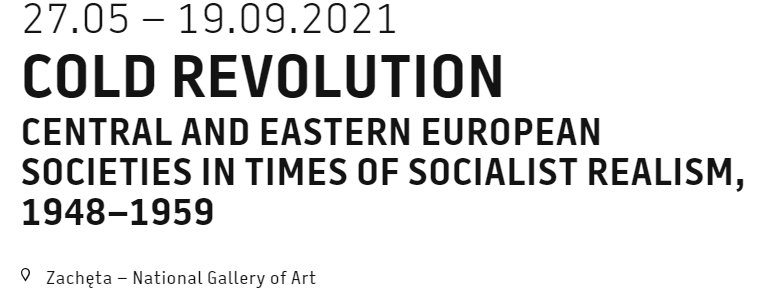
Screenshot der Webseite der “Nationalen Kunstgalerie Zachęta (Zachęta Narodowa Galeria Sztuki)” (Ausschnitt) [10.08.2021]
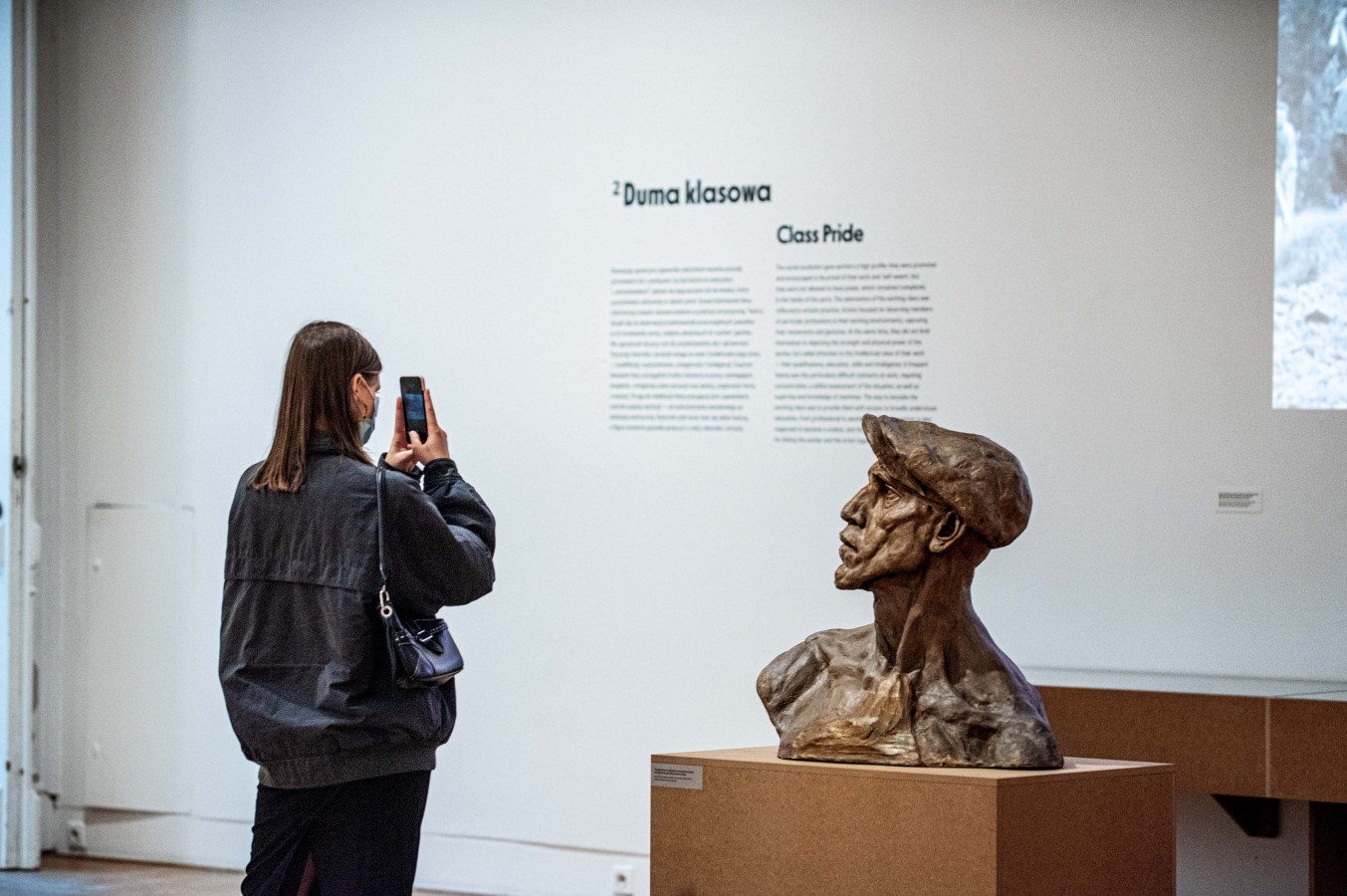
Cold Revolution. Central and Eastern European Societies in Times of Socialist Realism, 1948-1959, exhibition view, Zachęta, photo by Magda Hueckel
When the Images Looked at the Workers
Joanna Kordjak, Jérôme Bazin
When we look at Socialist Realist images today, in the 21st century, each of us having different social experiences and political sympathies, we ask ourselves many questions. Because we know that these images were created under the conditions defined by Stalinist and post-Stalinist dictatorships, they question our attitude towards dictatorship (and hence towards democracy). Because these paintings do not fit into the accepted narrative of 20th century art, they call into question our knowledge of the visual creation of this century and the way we order this knowledge.
Because they refer to a period that is already distant, but often recalled in memory discourses, they make us question our attitude towards the past, what we know about it and how we use it. Although they speak of the epoch to which we are heirs, a large part of them have already become incomprehensible and alien to us. One of the most problematic issues is proletarism and the valorisation of the working class in the frame of the dictatorship of the proletariat – whether we see it as an unfulfilled promise or an irritating masquerade staged by the regime, it remains the most alien, distant and therefore most intriguing phenomenon. Paintings depicting proud and self-confident workers provoke the question of what our attitude is towards the past and present working class, what we think about them and what we expect from them.
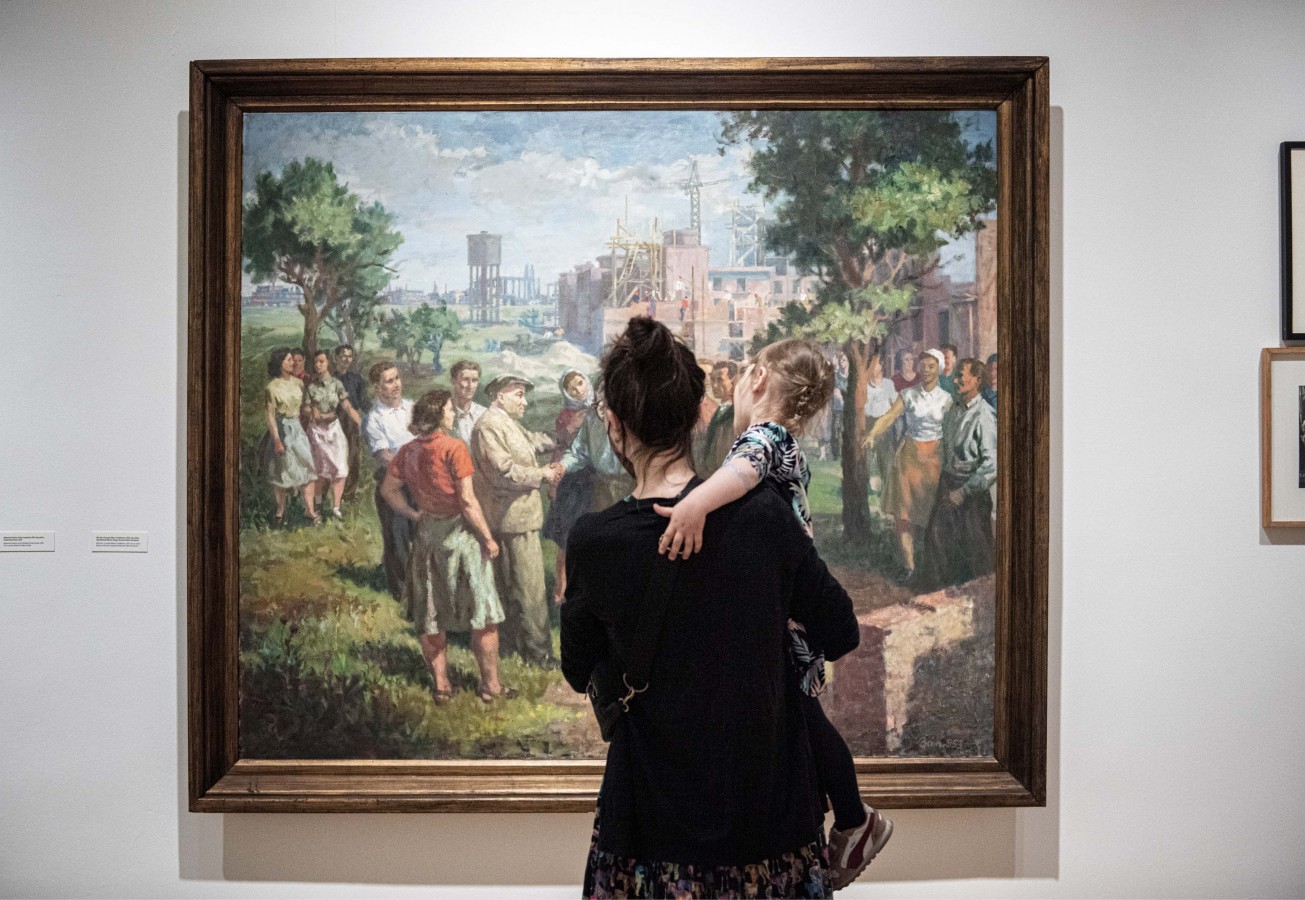
Cold Revolution. Central and Eastern European Societies in Times of Socialist Realism, 1948-1959, exhibition view, Zachęta, photo by Magda Hueckel
Cold Revolution
The word „revolution“ has a variety of meanings. In Central and Eastern European socialist countries, it was used to describe the end of World War II. It brought with it different expectations, associated with the violent, irreversible and inevitably violent processes of change taking place in each of these countries.[1] The partisan uprisings in Czechoslovakia and Bulgaria corresponded to the definition of a revolution as a mobilisation of popular masses modelled on the October 1917 revolution. Countries such as Germany, Hungary or Romania were not the arena of such movements.
Recently, historians have given a different definition of revolution, directing our attention to war times.[2] They describe war as a revolution in the sense of a cataclysm caused by the extermination of the population, mass displacement, the shaking up of social structures and widespread misery (of varying degrees depending on the country). The time just after the war definitely brought an end to the old world due to the displacement of large groups of the German-speaking populations, the exchanges of populations, the agricultural reforms of 1945-1946 and the nationalisation of industry, which took away the means of production from the richest.
The revolution referred to in this book is something else. It happened in the 1950s, when the communist regimes finally established their power. It was a revolution in the sense of creating a new social structure: a new proletariat emerged within a planned economy, a new peasantry involved in the process of collectivisation, a new middle class, new leaders (party cadres) dividing the privileges of the social pyramid summit with former elites, who were forced to redefine their place. The terms „industrialisation“ or „urbanisation“ are commonly used today, but they do not reflect the scale and significance of these transformations, the project of a new social order and the uniqueness of the political and social moment. It was a revolution because the centre of attraction shifted to the working class – it was no longer the elite, but the lower layers of society that were to occupy a key place in it.
What makes us connect the adjective „cold“ with this word? This, of course, is a reference to the political context of the Cold War. But the expression „Cold War“ is misleading, even if it is irresistibly imposed on us today. At that time, people in the countries of Central and Eastern Europe did not speak of it, and the confrontation with the West had then nothing „cold“ in it; on the contrary, in different parts of the world it meant actual wars and in Europe it meant a real threat.
The word „cold“ refers primarily to the climate of political freezing. It is a terrifying cold of Stalinism, acts of arbitrary violence and fear, embodied for us in places such as the prison in the Prague district of Pankrác and the forced labour camps – for instance those on the Romanian Danube-Black Sea Canal or the Belene camp in Bulgaria. After 1953, the number of acts of physical violence decreased, and in certain areas of life (cultural creation and foreign exchanges) political pressure weakened, but the experience of brutal dictatorship remained. The thaw in political life creates its own mechanisms of violence, pressure and threats. As in nature, it can be dangerous if ice melts too quickly or if everything freezes again afterwards.
The term „cold“ raises the question of the degree of involvement of the whole society in the revolution of the 1950s and the temperature of revolutionary zeal with which the building of the new world began. Was communism just a project imposed from outside on nations that only aped it without conviction, or was it something that they assimilated and in which they got involved during this turbulent decade? What was the revolutionary energy of Central and Eastern European countries in the 1950s? Explications referring to the categories of illusion and disillusionment seem too schematic to reflect the complexity of moods and political sympathies related to communism.
The use of the word „cold“ is also intended to encourage us to take a new look at the objects from this period. The art of the 1950s usually boils down to images of cheerful workers surrounded by a nimbus of warm colours. Such representations existed, of course, but they reflect only part of the visual production of that time. We want to show it in its entirety, drawing attention to less obvious works – those that deviate from this stereotypical notion, which contain coldness, melancholy, austerity and anxiety.
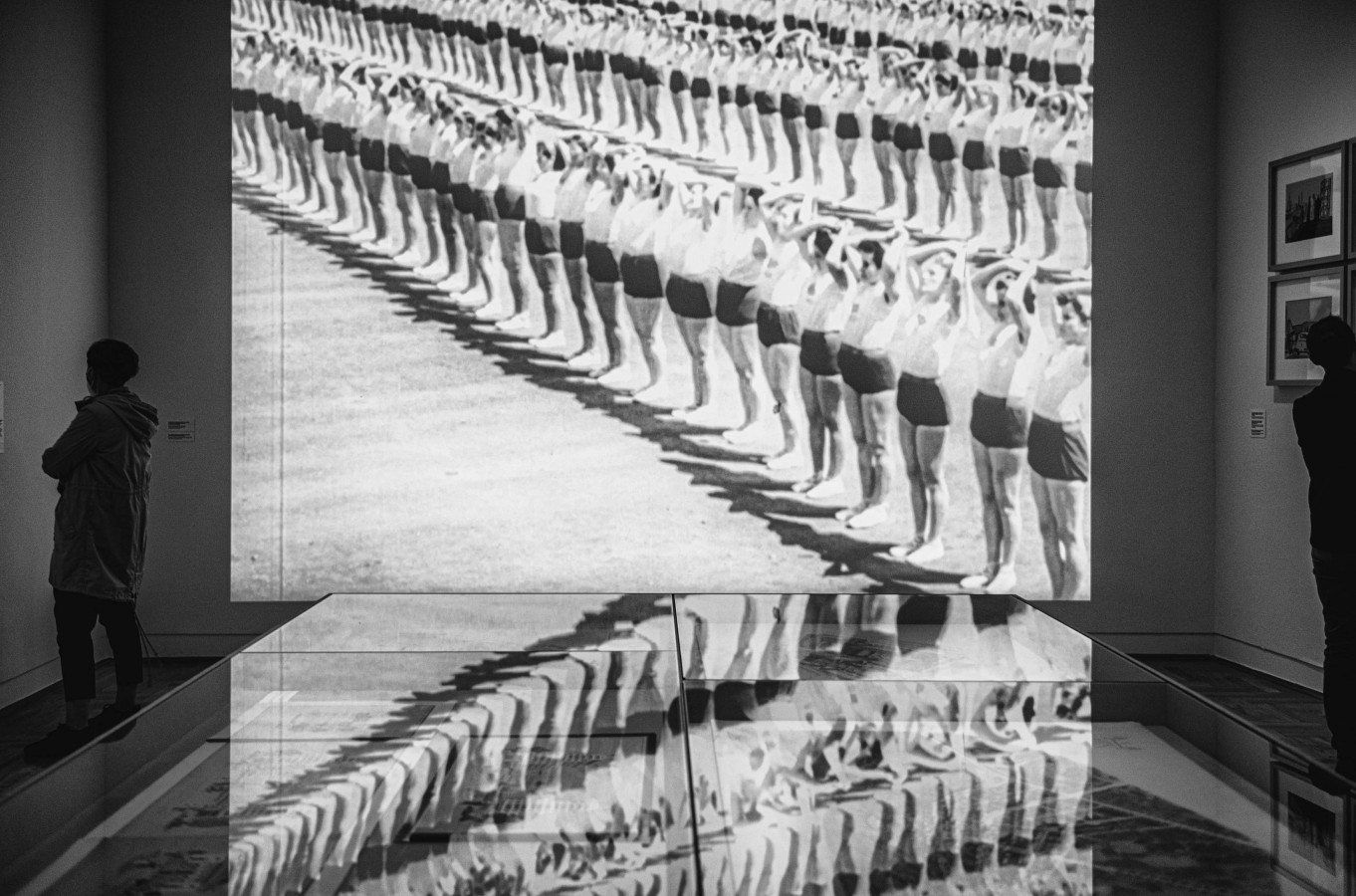
Cold Revolution. Central and Eastern European Societies in Times of Socialist Realism, 1948-1959, exhibition view, Zachęta, photo by Magda Hueckel
Finally – contrary to the belief that socialist art was cut off from social reality – we hope to show that Socialist Realist visual culture entered into relations with this reality and reflected its dynamics. With such a goal in mind, we are taking up a debate with a thesis first formulated in 1957 by Albert Camus and later developed by Evgeny Dobrenko, according to which Socialist Realist „descriptiveness” is radical and self-referential: Socialist Realism describes a world to the existence of which only it bears witness’.[3] In contrast, we believe that in that cold of Socialist Realist art, some part of the truth about the social reality of the time has been „preserved”. From among the numerous representations we have chosen those that can shed new (cold) light on the hard, harsh realities of that era.
The Stories of the Workers
Thus, the book Cold Revolution (and the exhibition it accompanies) concerns mainly workers (not artists or people who supervised artistic activity). They are not just the subject of the depictions, but important actors in social life. Already in the socialist era, many historians wrote about them and our contemporary researchers[4] analyse their working and living conditions, earnings, their private and everyday life. By finding traces of their voices in the archives, they are able to recreate their political attitudes and activities, sometimes contradictory to the aims of communist regimes, sometimes convergent.
In drawing the picture of peasant and working classes of that decade, historians draw attention to their extraordinary mobility and dynamics. Unlike the period of late socialism, a time of deals with socialist regimes, the 1950s were a period of confrontation. It was an era of growth — in the sense of increasing output – but dissatisfaction was spreading. Collectivisation of rural farms repressed men and women, and destroyed traditional forms of production as the basis of the overall countryside system. Exorbitant production norms in workshops and factories, low wages and price increases, partial lack of employment (there was unemployment in the 1950s, although it was not registered) – all of this became a breeding ground for protests. The popular classes had to face the violation of freedoms and poverty (although its degree is a relative value – in the memoirs of Edmund Chmieliński, a worker from Nowa Huta at the time, the beginning of the 1950s was an era of abundance after wartime shortages).[5]
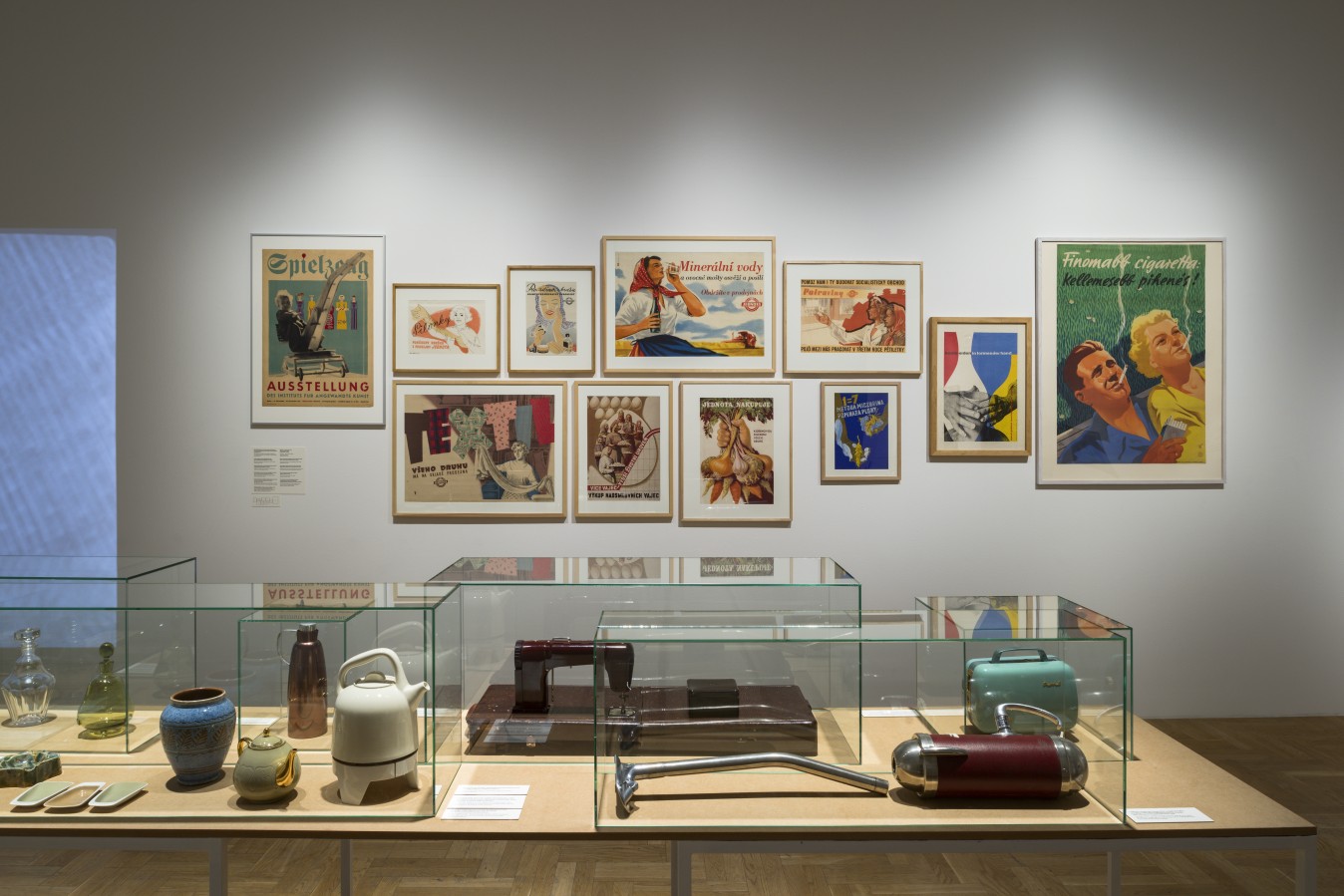
Cold Revolution. Central and Eastern European Societies in Times of Socialist Realism, 1948-1959, exhibition view, Zachęta, photo by Daniel Chrobak
Dissatisfaction led to revolts like the one in Plovdiv (May 1953), then in the German Democratic Republic (GDR) (17 June 1953) and Poznań (June 1956), as well as other workers’ speeches, during which – apart from the issue of production standards and price increases – the problem of imprisonment was raised and the abuse of law enforcement agencies was condemned. The riots in Budapest in October 1956 mobilised various social groups and working circles to pursue their own goals.[6] In all these cases, to varying degrees, the authorities suppressed the resistance. The party, nominally the avant-garde of the proletariat, led it, but did not represent it and rarely listened to its voice.
This persistent turmoil was fuelled by another phenomenon, important for the message of our exhibition: the workers were constantly advanced and promoted, but they were not allowed to come to power. They were to be celebrated, they were to be „self-aware“ and proud of their work, but they should not reach for the power that was completely in the hands of the party. Every attempt to achieve trade union autonomy (which was often spectacularly reasserted between 1944 and 1948) was nipped in the bud.[7] Socialist Realism was to give workers a sense of faith in their own value and (according to Marxist ideology) self-confidence (Selbstbewusstsein). However, this was not tantamount to a sense of power, which the workers did not have.
By painting a portrait of the people’s masses, historians bring out yet another feature: the plasticity of social roles and the blurring of their self-definition. As a result of the upheavals during and just after the war, the processes of collectivisation and industrialisation, most individuals had to redefine their status, adapt to new places and new rules of life. People improvised and created a kind of bricolage from new ways of acting and existence. This was particularly true of the women promoted at the time – they took on jobs they had not done before, thus gaining financial independence, and at the same time faced the persistent pressure of the old definitions of gender roles. Everyone had to choose a strategy and make a choice:[8] join the cooperative or try to stay out of it. Stay in the countryside or leave. Pick a sector to work in. Mobility (even if it concerned a small territory) was key here – employee turnover became a recurring problem in the 1950s, as we know from the archives of companies that had great difficulty in retaining their workforce. It was an era that opened the way for social advancement and offered a variety of possibilities: to move to the position of qualified worker or to join a group of white collar workers (foreman, economic or political director, accountant, clerk, teacher, etc.). The advancement of the lowest social classes at that time was significant, but often led to disappointment, resentment and frustration, caused by unfortunate choices. Society was thus populated by peasants being transformed into workers, peasant-workers, craftsmen moving to large factories, women seeking and sometimes succumbing to the pressure of the new model of gender relations. Behind the façade of the official categories („workers“ and „peasants“) there was a whole crowd of people with unclear social affiliation – what art history would call profil perdu.
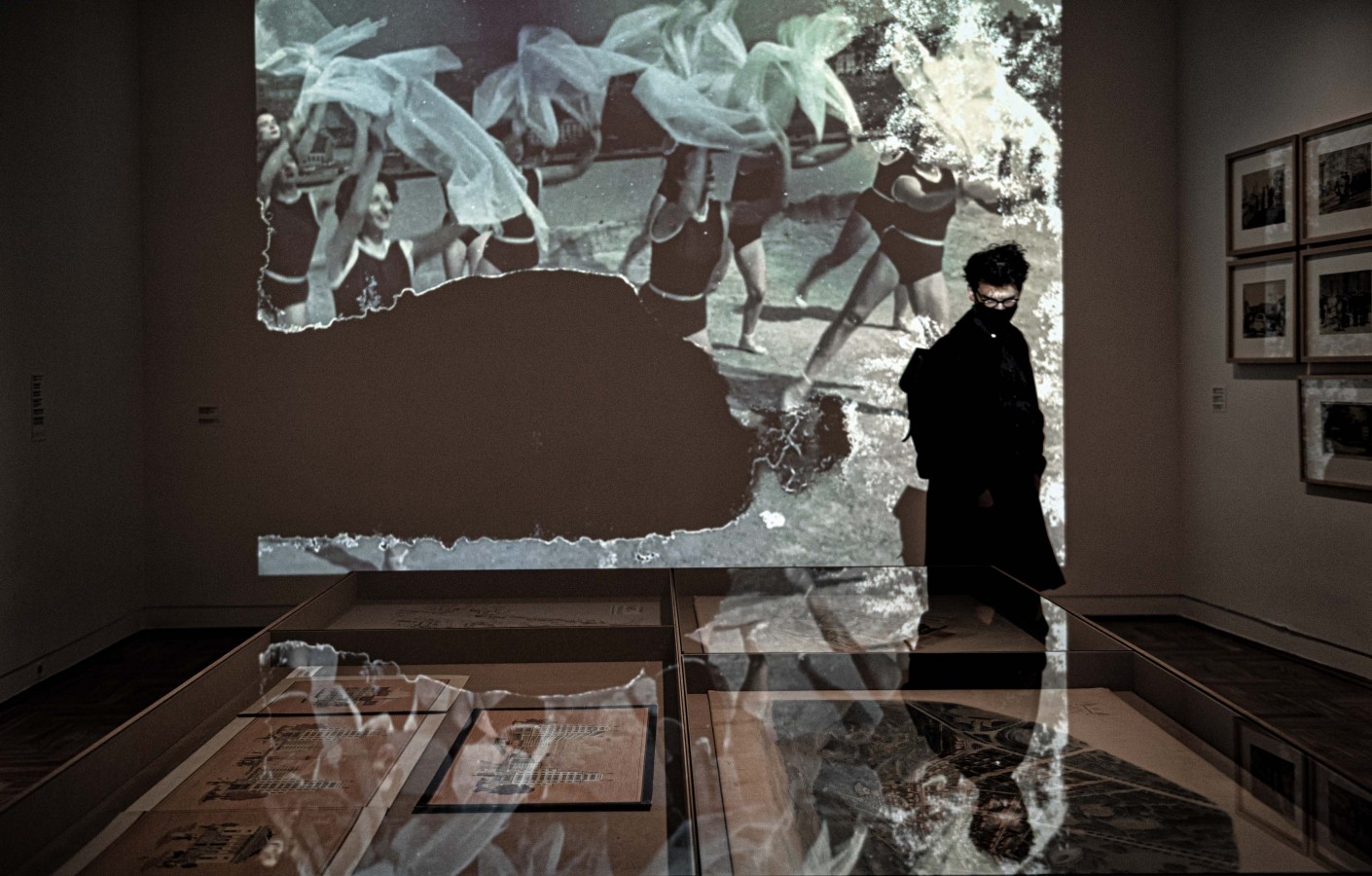
Cold Revolution. Central and Eastern European Societies in Times of Socialist Realism, 1948-1959, exhibition view, Zachęta, photo by Magda Hueckel
What role did images of the workers play for them? How did they receive them? Archives (reports, surveys, questionnaires) and interviews shed some light on this issue. However, they mainly bring to the forefront the fact that generalisations must be avoided because the reactions were very different. The claim that workers either approved or rejected Socialist Realist images is undoubtedly too simplistic. What they were sensitive to was quite different. They may have noticed a discrepancy between the reality in which they lived and its representations in art. They could feel valued, seeing in them signs of the respect that the socialist regime had for them. They could also look for an escape from reality and entertainment, but they could also be attentive to the images of themselves and the social group they represented. It cannot be ruled out that the workers’ audience, like any other, was divided and varied in their opinions.
Exhibiting Socialist Realist Images Today
How do we show images from this time today? We did not choose to present the career of artists or to reconstitute the institutional and financial framework within which the objects were created. In the case of the 1950s, this problem is complex – the institutions ceased to exist after a short time, their prerogatives were often poorly defined.[9] The exhibition also omits the question of how the works of art were exhibited at the time and places all objects on the same plane – whether they were shown or not, whether they were appreciated or criticised. The division into such categories is too simplistic; one has to take into account a wide range of forms of visibility – many works were only exhibited for a short time or in a specific place. It was also difficult to take into account the entire complexity of censorship procedures at this exhibition. Many of the themes deliberately omitted from the exhibition (careers, institutions, censorships) are discussed in the articles collected in this book.
The exhibition directs attention to the object itself. Contrary to the stereotypical belief that objects from this time are uninteresting, not worth showing and seeing, we want to draw attention to their aesthetic value, to their form, going beyond the template of artistic labels, especially the two basic ones: „Socialist Realism“ and „modernism“. These terms sparked tedious, endless disputes in the 1950s. „Socialist Realism“ was used by artists in the Stalinist era to protect themselves from censorship. After 1953 and 1956, it was used for various purposes, in some countries it was preserved and redefined, in others it was abandoned. „Modernism“ was most often used for contrast, grouping under this motto very different artistic currents and tendencies, which were reduced to their purely visual properties. We assume that disputes over words, even if they were important in the epoch because they broke or built someone’s career, make it difficult to see the objects today.
One of our goals is also to include Socialist Realism in the processes of transformation of 20th century art and to show it in its surprising diversity (including formal, resulting from the failure to define these requirements in doctrine), ambiguity, visual richness – it is more justified to talk about multiple Socialist Realisms rather than one. Going beyond the dichotomy of official/unofficial (recognised/rejected) art, we include in our field of interest works that can be described as the „margins“ of Socialist Realism. These are not so much the attitudes formed in opposition to the mainstream as the assorted variants, deviations or new formulas of Socialist Realism represented individually by some artists. Among the attempts to maintain artistic autonomy in the face of the top-down imposed requirements, we can list Andrzej Wróblewski’s formula of „Direct Realism“ (actualised, among others, in the Executions series) or Hans (János) Mattis-Teutsch’s paintings, combining his pre-war avant-garde experience with Socialist Realism iconography.
Certainly, the exhibition themes are not limited to aesthetic issues. We are not reconstructing the local contexts in which the presented objects were created; however, the common denominator of all of them is the theme of the great social challenges faced by the masses within the proletariat’s dictatorship: relations between the city and the countryside, hierarchy at work, conflicts, professional qualifications, education of workers, possession of goods, bonds with workers from other parts of the world, building one’s own identity anew. We are trying to capture the accompanying emotions – hopes, enthusiasm, but also disappointment.
A last note concerns the geographical frame of the exhibition. It covers six countries (within the borders of the time, there are seven now, after the split of Czechoslovakia), but it does not group works because of the place where they were created, thus depriving them of their national anchor. Placing objects of different origins next to each other allows us to free ourselves from the narratives of individual countries and avoid duplication of discourses (present and past) that lock art in self-presentations and „national heritage“.[10] The territory referred to by the exhibition is not a nation, but the vast area whose current, least controversial term is „Central and Eastern Europe“. The countries of this region share the experience of state socialism, shaped after 1944 according to the Soviet model. However, there are many differences between them, which at the time seemed obvious (nobody was talking about Central and Eastern Europe yet), and this is still the case today. The most important of these concerns the social structure. In Germany and Czechoslovakia, industrialisation was already well under way before 1945, which translated into the size of the working class, while countries such as Romania and Bulgaria were rural (and remained so in the 1960s). However, such territorial divisions reveal some gaps and need to be re-discussed. The drawing of a primitive plough in Curt Querner’s landscape reminds us that agriculture in East Germany could be backward and inefficient. Max Hermann Maxy’s portrait of workers in Jiu valley shows that Romania, a predominantly rural country, also had an industrial and proletarian tradition. Central and Eastern Europe is therefore particularly interesting for questioning the narratives on social modernity (the mass transition of the rural and agricultural worlds to the urban and industrial worlds). It was in the 1950s that the definitions of what is rural and what is urban collided in this vast area. The approach we propose gives an opportunity to revise our understanding of the social modernisation processes taking place at the time.
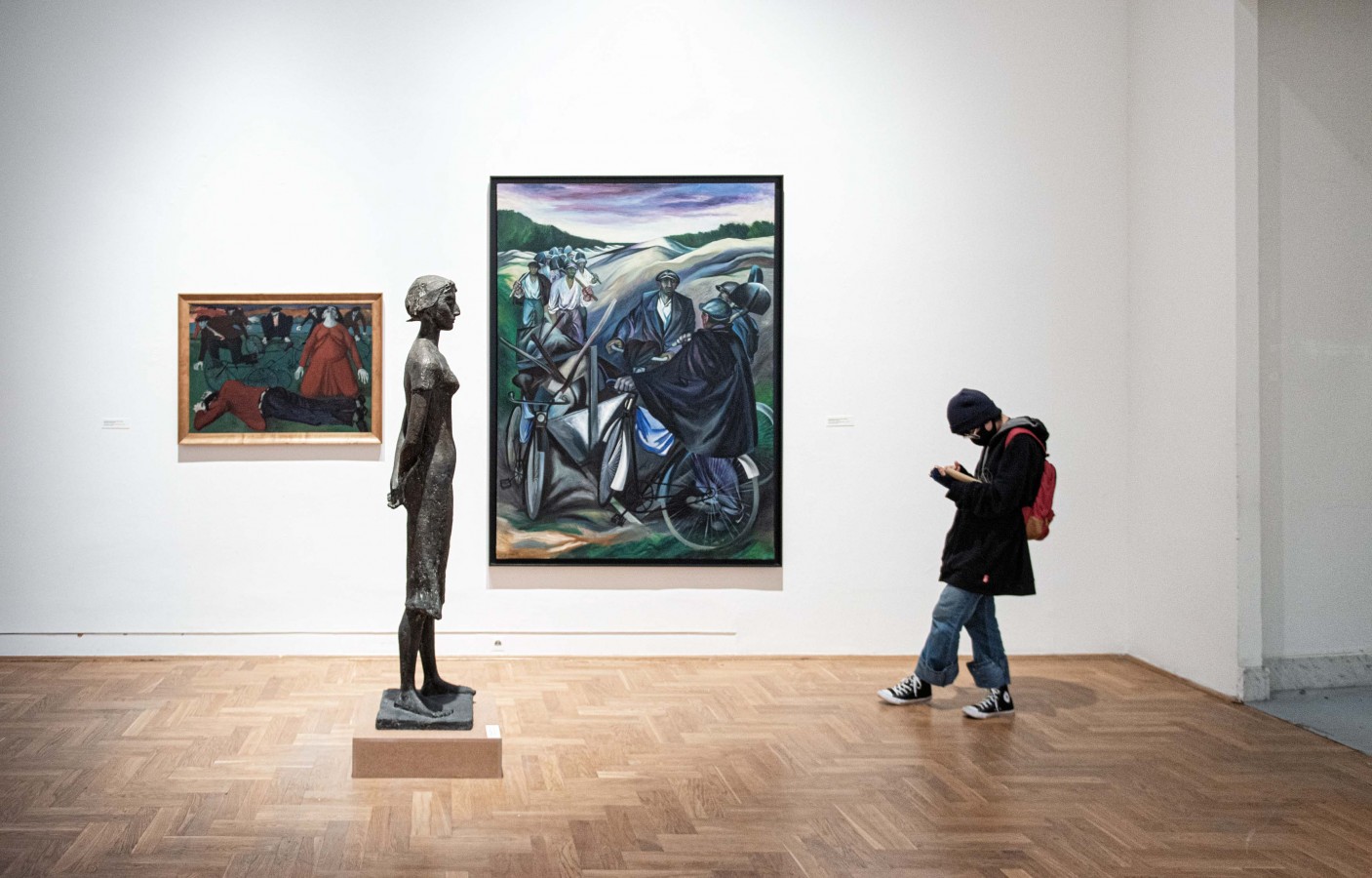
Cold Revolution. Central and Eastern European Societies in Times of Socialist Realism, 1948–1959, exhibition view, Zachęta, photo by Magda Hueckel
A Narrative of the Exhibition
Considering the crucial importance of the disaster of World War II for the course of the social revolution of the 1950s, we decided to begin the narrative of the exhibition with works directly related to the war events, such as Ladislav Guderna’s Partisans or Iliya Pefev’s Awaiting a Signal for the Uprising (in the Bulgarian and Czechoslovakian visual culture, the themes of the local partisan movements were very popular). Other works, such as the East German film The Bridge (Die Brücke, dir. Artur Pohl, 1949) or Andrzej Strumiłło’s painting Our Land (1953-1954), deal with the consequences of the war – migration and resettlement as a result of geopolitical changes, seen from different perspectives on both sides of the new Polish-German borders. They show both the enthusiasm of the new „beginning“ associated with the settlement of the so-called Recovered Territories (in the paintings of Polish painters) and the feeling of uprooting and alienation accompanying the forced migration (intensified by the conflict with the local population) that resound in the East German film production. As a result of numerous migrations, the feeling of being a foreigner in one’s own country became practically ordinary, which is why the countries of this new settlement can be called „cold homelands“.[11]
The exhibition then shows how the visual culture of this period was integrated into the process of building a new social hierarchy. A poster by East German designer Klaus Wittkugel was a perfect match for the propaganda rhetoric aimed at making the working class more valuable. The young miner’s depiction was accompanied by the question I’m a miner! Who is more? Thus, in the new socialist reality, was it possible to be more? This group was appreciated by including in Socialist Realist iconography such topics as social advancement, embodied in the working heroes of the time, workers portrayed as the new bourgeoisie, the new elite, as in Walerian Borowczyk’s lithograph Young Bricklayer on Sunday (part of the Nowa Huta series from 1954).
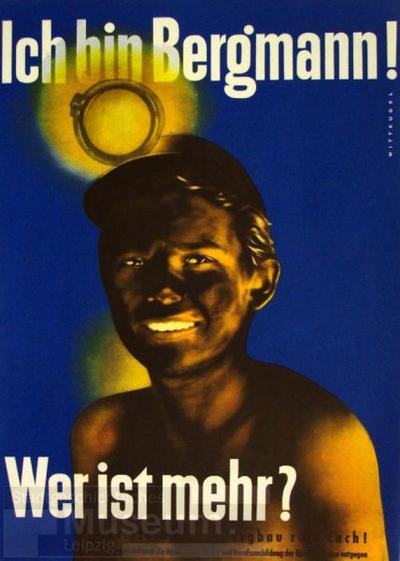
Klaus Wittkugel, Plakat: Ich bin Bergmann! Wer ist mehr?, Quelle: Europeana, Lizenz: CC BY-NC-SA 4.0
An important thread of Socialist Realist art was the new way of understanding and presenting work. We find here paintings showing its physical hardship and toil, but they were not limited to presenting the strength and physical fitness of the worker. The artists’ aim was to draw attention to the intellectual value of a labourer’s work — their qualifications, education, skills and intelligence. Artists focused on showing particularly difficult moments at work, requiring concentration, skilful assessment of the situation and knowledge, expertise and machinery.
The way to ennoble the working class was to provide them with access to culture and education, broadly understood, including aesthetic education. In this context, we draw attention to the political, social and cultural phenomenon of cultural centres in post-war Central and Eastern Europe. In accordance with their purpose, they served the education, development of readership, as well as entertainment and integration of the local community. No less important was the impact of the architecture of the buildings themselves on users, especially the visually rich interiors, which offered a new quality of sensory experience.[12] The community centres were also places of activity of amateur artistic circles, film and photographic clubs.
Another important aspect of social and customs change was the democratisation of access to material goods, or rather the democratisation of the desire for material goods. In a reality of shortages, lacks and widespread poverty, visual culture was saturated with images of abundance. In Socialist Realist culture, plenitude and happiness were placed in the future; they were a promise which was only to be fulfilled as a reward for today’s effort and sacrifice. These ideas could be found in, among other places, advertising – an area whose function (in the face of the lack of competition on the market in a socialist economy) was directed towards raising the level of society’s personal culture (kulturnost’) and education. By creating desires and aspirations, the need for social advancement was also stimulated.
In the socialist system, everyday objects also had a different function. This was the assumption of the founder of the Institute of Industrial Design in Warsaw, Wanda Telakowska, who saw the new political and economic system of post-war Poland as a chance to implement two avant-garde ideas: total design (the overall design of a new society) and a „beautiful and cheap object for all“. She believed in the modernising potential of things and, like Soviet theorists, believed that objects should work for social change. The previously existing „passive“, „pseudo-objects“ (whose sole purpose was to decorate everyday life), were contrasted with new socialist objects, combining aesthetic functions with human practice.
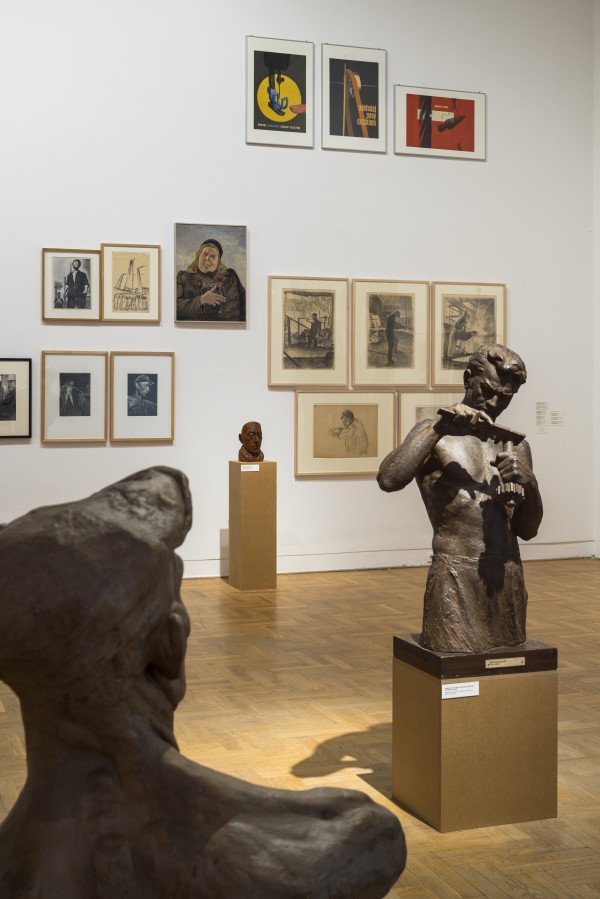
Cold Revolution. Central and Eastern European Societies in Times of Socialist Realism, 1948–1959, exhibition view, Zachęta, photo by Daniel Chrobak
In the exhibition, we would like to draw attention to the discrepancy between the image of the unity of the working class, recorded in official materials, and the actual situation: the tensions and conflicts that emerged within this social group during this period. Contrary to propaganda rhetoric, the working class was not a monolith, and its internal hierarchy was uncertain. Disputes were revealed on the countryside-city plane (between peasant and workers), but also over generation, gender and ethnic background. The art of the time was reflected in the conflict between generations, usually reduced to a simple old/young opposition, in which the old personified backwardness, while the young personified the new order and progress. We also examine how the propaganda-carrying idea of gender equality and the professional emancipation of women translated into the representation of this phenomenon in art.
Despite the ethnic unification of societies in this part of Europe as a result of World War II (extermination of Jews and Roma) and post-war purges, they were not quite ethnically homogeneous. In this context, we are interested in how national minorities were represented in the visual culture, how their otherness was adapted and how propaganda rhetoric dealt with the „dangerous potential“ of these groups.
Another source of internal conflicts and tensions was the communist authorities’ campaign of labour competition, breaking records in exceeding norms and rivalry between workers. At the centre of the conflict were the work leaders, whose position was definitely ambiguous. Awarded and promoted by the authorities as heroes of the working world, they aroused distrust and a sense of threat in some workers. Paradoxically, breaking out of the collective, they also became a potential threat in the eyes of the authorities. The theme of competition and depiction of model working people, recognisable by name, was one of the main themes of Socialist Realist iconography.
The intense political, social and economic changes reflected the rapidly changing landscape. And it is precisely this landscape – captured in the process of transformation – that became an object of interest for Socialist Realist art. It could not remain politically neutral. In socialist visual culture, there was a shift from a vision of nature untouched by humans (as a convention typical of bourgeois culture) to a new approach to landscape, in which two factors played a decisive role. On the one hand, it was a search for a homeland as a response to the need to reconstruct a national identity (in the context of the new geopolitical situation – the case of Poland). On the other hand – and this aspect seems crucial – the Socialist Realist landscape was supposed to reflect the traces of contemporary human intervention, reflect the political and social transformations following industrialisation (the images of this process of degradation of nature became a glorification of progress) or agricultural reform. It showed the „new face“ of the countryside and intensive urbanisation, documenting for example the construction of new cities.
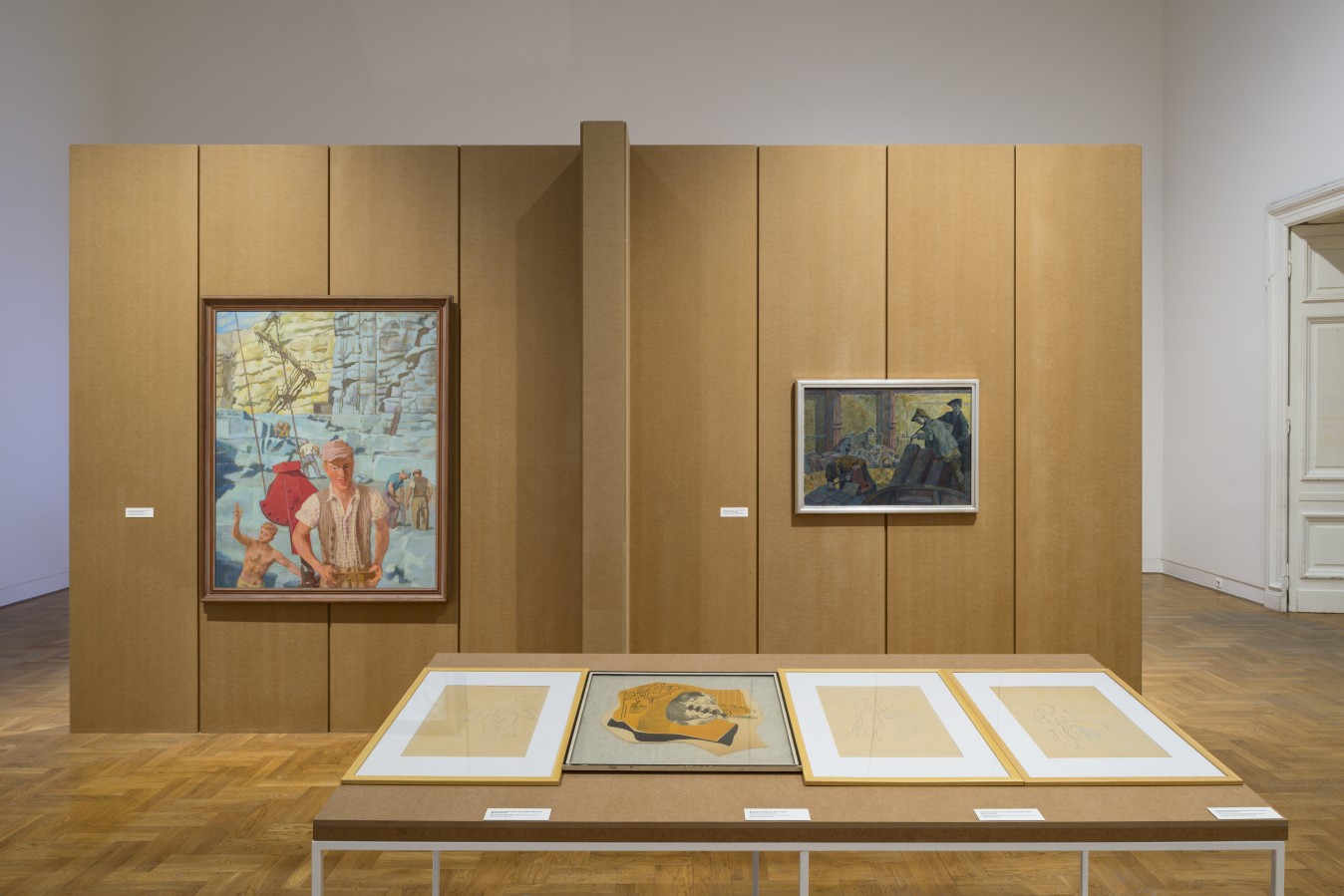
Cold Revolution. Central and Eastern European Societies in Times of Socialist Realism, 1948-1959, exhibition view, Zachęta, photo by Daniel Chrobak
Architectural and urban planning concepts were subordinate to the leading propaganda vision of the unity of the working class. Urban planning was part of the already mentioned strategy of building the identity, pride and prestige of the working class, which can be seen in the example of new city districts or cities built from scratch in this part of Europe. At the same time, they served the authorities as ideal stage setting for propaganda performances (the suitably wide avenues and extensive squares were subordinated to this function). The specially designed architecture of cities allowed to curb and control potentially dangerous social groups (such as youth or ethnic minorities). However, despite the oppressive policy of the authorities, the working class resisted the discipline. One of the earliest and most important moves against the communist authorities was the uprising of 17 June 1953 in East Germany, bloodily and swiftly suppressed. The uprising was started by workers employed in the most representative district of East Berlin — Stalin Allee.
The issue of the cult of the individual appears in the exhibition in a new light: a political leader, by the power of their very personality, is called upon to consolidate a deeply divided nation, as evidenced by the images of the leader among the representatives of a divided society. The vision of the working class united around their leader, as captured in the propaganda message, is confronted in the exhibition with the theme of the workers’ rebellion, which for obvious reasons was almost unrepresented in the art of the time (only in an allusive or critical way, as in Werner Tübke’s paintings condemning the 1956 Revolution in Hungary). In the East German press, participants of the 1953 strikes were stigmatised as enemies of the people and it was proclaimed that the fascist movement supported by the Americans was behind the events. Accusing political opponents of links with American imperialism and fascism was a constant practice of Stalinist rhetoric, which found a perfect reflection in the visual culture of the 1950s. The common enemy brought people together, across international divides, regardless of latitude. In the exhibition, we show Socialist Realist art whose theme was the oppression of workers in more distant regions (such as Mexico or the countries of South America, North Korea or Vietnam), as well as the better known United States or Western European countries. They include the art of Italian or French communist painters (such as Renato Guttuso, Gabriele Mucchi or André Fougeron). Although they were created in a different political context, in the eyes of artists from the Eastern Bloc countries, it legitimised Socialist Realism and provided a model that was much more eagerly used than the Soviet model. The exhibition concludes with a look at the workers from behind the Iron Curtain, from distant parts of the world.
The starting point of the exhibition concept is the conviction that images are capable of shaping social reality – regardless of whether they have been censored or appreciated by the authorities. The selected objects are those that touch this reality in different ways. Experiencing them with sensitivity may lead today’s viewers to reflect on the social dilemmas of the time. Let us emphasise: the exhibition offers objects whose visual shape stimulates reflection. This is perhaps its most controversial moment: these works, although created under the overwhelming pressure of censorship that hindered free thought, did not lose their reflectiveness. The question may arise whether by showing the works of the past marked by dictatorship and thus giving them credit, we are not raising the rank of the proletariat’s dictatorship itself. However, does displaying it necessarily mean giving it value? Such reasoning reduces the museum to only one of its functions: promotion, and thus to hierarchy and the setting of standards (and consequently prices on the art market). The exhibition rather fits in with the aspirations of the critical museum, whose idea has been defended by Katarzyna Murawska-Muthesius and Piotr Piotrowski[13] – a museum that focuses on a viewer’s ability to look at objects they do not recognise themselves in, but which stimulate reflection and questions precisely because they are alien to them.
[1] See Roumen Daskalov, Debating the Past, Modern Bulgarian History from Stambolov to Zhivkov,Budapest and New York: Central University Press, 2011, p. 225.
[2] See Bradley F. Abrams, Second World War and the East European Revolution, East European Politics and Societies, vol. 16, no. 3, 2002, pp. 623-664; Jan Gross, Social Consequences of War:Preliminaries to the Study of Imposition of Communist Regimes in East Central Europe, Eastern European Politics and Societies, vol. 3, no. 2, 1989, pp. 198-214; Andrzej Leder, Prześniona rewolucja. Ćwiczenia z logiki historycznej, Warsaw: Wydawnictwo Krytyki Politycznej, 2014.
[3] Evgeny Dobrenko, Political Economy of Socialist Realism, New Haven: Yale University Press, 2007, p. 13. See also: Boris Groys and Max Hollein, eds., Traumfabrik Kommunismus. Die visuelle Kultur der Stalinzeit, Ostfildern: Hatje Cantz Verlag, 2003.
[4] See, among others, Peter Hübner, Christoph Klessman, and Klaus Tendfelde, eds., Arbeiter im Staatssozialismus, Ideologischer Anspruch und soziale Wirklichkeit, Köln: Böhlau, 2005.
[5] Katherine Lebow, Unfinished Utopia: Nowa Huta, Stalinism, and Polish Society, 1949-1956, Ithaca: Cornell University Press, 2013, p. 55.
[6] Mark Pittaway, The Workers’ State: Industrial Labor and Making of Socialist Hungary, 1944-1958,Pittsburgh: University of Pittsburgh Press, 2012.
[7] Adrian Grama, Laboring Along. Industrial Workers and the Making of Postwar Romania, Berlin and Boston: De Gruyter Oldenbourg, 2019.
[8] David Kideckel, The Solitude of Collectivism, Romanian Villagers to the Revolution and Beyond, Ithaca and London: Cornell University Press, 1993; Gerald Creed, Domesticating Revolution. From Socialist Reform to Ambivalent Transition in Bulgarian Village, University Park: Pennsylvania State University Press, 1998.
[9] See for example Caterina Preda, ed., The State Artist in Romania and Eastern Europe, The Role of the Creative Unions, Bucharest: Editura Universităţii din Bucuresti, 2017; Katharina Pfützner, Designing for Socialist Need: Industrial Practice in the German Democratic Republic, London: Routledge, 2017; Иван Еленков, Културният фронт. Българската култура през епохата на комунизма: политическо управление, идеологически основания, институционални режими, Sofia: Институт за изследване на близкото минало, Сиела, 2008; Paul Kaiser and Karl-Siegbert Rehberg, eds., Enge und Vielfalt – Auftragskunst und Kunstförderung in der DDR, Hamburg: Junius, 1999.
[10] The national context was analysed in scientific works and exhibitions: Milena Bartolva and Jindřich Vybiral, eds., Budování státu: reprezentace Československa v umění, architektuře a designu, Prague: Umprum, 2015; Monica Enache, Artă pentru popor? Plastica oficială românească între 1948-1965, Bucharest: Bucureşti Muzeul Naţional de Artă al României, 2016; Alexandra Kusa, Prerušená pieseň. Výtvarné umenie v časoch stalinskej kultúrnej praxe 1948–1956, Bratislava: Slovenská národná galéria v Bratislave, 2019; Endre Prakfalvi and György Szücs, A szocreál Magyarországon, Budapest: Corvina Kiadó Kft., 2010; Krista Kodres, Kristina Joekalda, and Michaela Marek, eds., A Socialist Realist Art History? Writing Art History in the Post-war Decades, Köln: Böhlau, 2019.
[11] Andreas Kossert, Kalte Heimat. Die Geschichte der deutschen Vertriebenen nach 1945, München: Siedler, 2008.
[12] David Crowley and Susan E. Reid, Style and Socialism. Modernity and Material Culture in Post-war Europe, Oxford: Berg, 2000; Marina Balina and Evgeny Dobrenko, Petrified Utopia. Happiness Soviet Style, London: Anthem Press, 2009.
[13] Katarzyna Murawska-Muthesius and Piotr Piotrowski, eds., From Museum Critique to the Critical Museum, London: Routledge, 2016.
Weitere Empfehlungen und Hinweise rund um die Ausstellung:
Auf der Webseite der Nationalen Kunstgalerie Zachęta (Zachęta Narodowa Galeria Sztuki) finden sich zwei Video-Beiträge der beiden Kurator*innen Jérôme Bazin und Joanna Kordjak (Links zu den Videos unten). Ebenso sind weitere Talks, Vorträge und Bildbetrachtungen zur Ausstellung „Cold Revolution“ auf dem Youtube-Kanal der Nationalen Kunstgalerie Zacheta verfügbar, unter anderem ein interessantes Gespräch der beiden Kurator*innen mit Lucia G. Stach, die leitende Kuratorin der Sammlung für moderne und zeitgenössische Kunst in der Slowakischen Nationalgalerie (Slovenská národná galéria) in Bratislava.
Screenshot der Webseite der Nationalen Kunstgalerie Zachęta (Zachęta Narodowa Galeria Sztuki) (Ausschnitt) [10.08.2021]
Screenshot der Webseite der Nationalen Kunstgalerie Zachęta (Zachęta Narodowa Galeria Sztuki) (Ausschnitt) [10.08.2021]
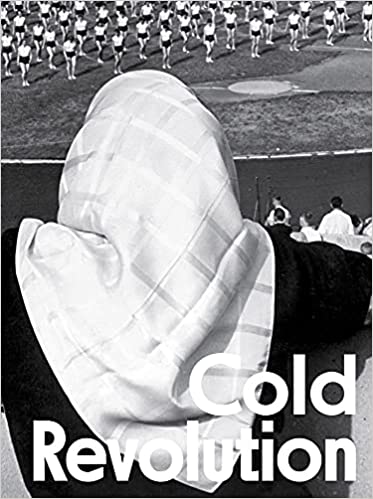
© Mousse Publishing
Der Band untersucht die Beziehung zwischen der visuellen Kultur der 1950er Jahre und der radikalen sozialen Revolution, die in Mittel- und Osteuropa in einem „kalten“ Klima wachsender internationaler Spannungen und der Stärkung der kommunistischen Diktaturen stattfand. Insgesamt dreißig Autor*innen aus unterschiedlichen Fachbereichen (Kunstgeschichte, Sozial-, Politik- und Kulturgeschichte) untersuchen die gesellschaftlichen Veränderungen der 1950er Jahre und präsentieren kultur- und kunstgeschichtliche Essays, kurze Schlüsseltexte und Analysen aus den Bereichen Malerei, Architektur und Stadtplanung, Design, Fotografie, Film und Grafikdesign, die für verschiedene Länder des Ostblocks wie Polen, die DDR, die Tschechoslowakei, Bulgarien, Rumänien und Ungarn beispielhaft sind.
Cold Revolution. Central and Eastern European Societies in Times of Socialist Realism, 1948-1959, ed. Jérôme Bazin, Joanna Kordjak, Warsaw and Milan: Mousse Publishing, Adam Mickiewicz Institute, Zachęta – National Gallery of Art, 2020



